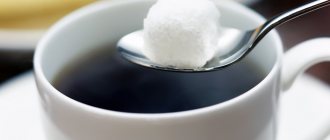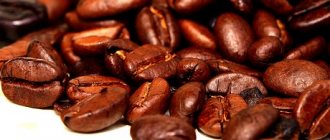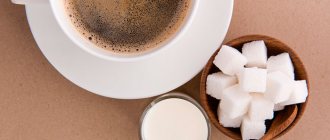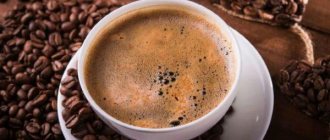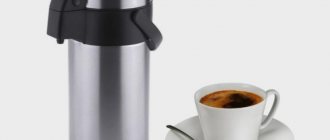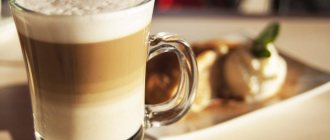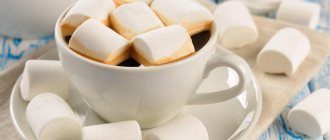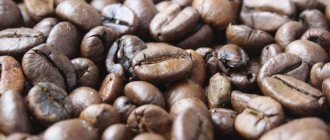Coffee is consumed by most of the globe and is the most traded commodity after oil. In recent years, more and more people are concerned about their health and counting the calories they consume, so they are concerned about the calorie content of coffee without sugar. According to statistics, on average people drink 2-4 cups of coffee a day, some even 5-6. And with such volumes, it is important to know whether you will exceed your norm.
How many calories are in coffee without sugar?
Coffee is an extremely low calorie product; on average, it does not exceed 5-6 kcal per 100 grams. Even if you drink 5 cups of 200 ml, the total amount of calories will be about 50-60. With an average rate of 1700 (for women) and about 2000 (for men), 50 is a very small number that will not have a serious impact. That is, you can drink almost liters of coffee without sugar and other additives, and it will not cause obesity. Another thing is that more than 5-6 cups a day is not recommended by doctors due to an excess of caffeine, fatty acids and other components.
Calorie table for coffee and coffee drinks without sugar and other additives
| Drink | Portion, ml | Calories per serving |
| Ristretto | 15 | 1 |
| Espresso | 30 | 2 |
| Americano | 180 | 2,2 |
| Americano double | 240 | 4,4 |
| Filter coffee in a drip coffee maker (regular) | 220 | 2 |
| Filter coffee in Chemex | 240 | 3 |
| Filter coffee in an AeroPress | 220 | 3,5 |
| Filter coffee in French press | 200 | 4 |
| Coffee brewed with cold water | 240 | 6 |
| In Turkish, in cezve | 200 | 4 |
| Soluble granular | 200 | 12 |
| Soluble freeze-dried | 200 | 24 |
| Chicory | 240 | 46 |
| Green coffee | 220 | 0 |
| Decaffeinated coffee | 220 | 5 |
Conclusions:
- Basically, the calorie content of the drink depends on the amount of granulated sugar added - 390 kcal per 100 grams of sand, 400 for refined sugar.
- For maximum convenience of counting, you can take a heaped teaspoon of granulated sugar for 30 kcal.
- Instant coffee itself has more calories than natural coffee, and a drink in a standard 200 ml glass with two sticks / refined sugar cubes / level spoons of sugar is 50 kcal.
- In an average portion of natural coffee ~200 ml and with two sticks / cubes of refined sugar / level spoons of sugar - 40-43 kcal.
Calorie content of natural black coffee without sugar
Natural grains contain natural sugars and fats, as well as some protein, and the fresher the roast, the more of them. During long-term storage, they partially evaporate, especially if you buy already ground coffee and store it in unsealed packaging. If you grind freshly roasted beans immediately before drinking and prepare coffee, its calorie content can increase by 0.5-1 kcal per 200 ml cup.
The longer the grains are in contact with water, the more nutrients are released and transferred into the drink. Therefore, in espresso or ristretto, which are prepared quickly in coffee machines, the number of calories is minimal - usually 1 kcal per serving. A drink prepared in a filter contains more calories, about 3-5 per 200-240 ml cup. French press or Turkish coffee takes the longest to brew and contains about 4 calories per 200 ml.
Calorie content of Arabica and Robusta
Different types of coffee beans have their own characteristics. The most commonly found on the market are Arabica and Robusta; mixtures of them are often sold (60% Arabica + 40% Robusta).
| Arabica | Robusta | |
| Fats | 15-17% | 10-11% |
| Acids | 5-8% | 7-10% |
| Sahara | 6-9% | 3-7% |
We see that Arabica contains a little more fat and sugar, which will be transferred into the drink when cooked. And the longer your coffee brews, the more calories you'll get. However, for a cup of coffee the difference will be 0.5 - 1 kcal, which for most people, even those who carefully count calories, is not so significant. If you like Arabica, there is no point in switching to Robusta just because this will reduce your diet by 4-5 kcal per day.
Carbohydrate content of popular coffee drinks
Drinks made with just espresso and hot water, such as Americanos, contain no carbohydrates.
However, coffee or espresso made with ingredients other than water usually contains carbohydrates. Milk and flavored syrups are two common sources.
Most coffee drinks can be customized and their carbohydrate levels depend on what ingredients are added to them. For example, whole milk contains more carbohydrates than unsweetened almond milk.
Here are some popular coffee and espresso drinks and their potential carbohydrate levels:
- Coffee with milk (ratio of black coffee and milk 1:1) . Your drink will contain 6 grams of carbohydrates if it is made with 120 ml of whole milk or only 1 gram if it is made with unsweetened almond milk (,).
- Cappuccino (ratio of espresso to milk and milk foam 1:1:1) . A 480ml cappuccino made with 2% milk contains 12 grams of carbohydrates ().
- Latte (espresso to milk ratio 1:3) . This drink will contain more carbohydrates since it is mostly milk. If you choose to add a flavored syrup such as vanilla, just 30 ml can add 24 grams of carbs.
- Flat white (ratio of espresso to milk and milk foam 1:3:2) . This drink contains about the same amount of milk as a latte and therefore contains the same amount of carbohydrates.
- Mochaccino (chocolate cappuccino) . This drink is made from milk and chocolate syrup, which contains carbohydrates. A 480ml mochaccino made with 2% milk contains 44 grams of carbohydrates ().
Many coffee shop drinks are also topped with whipped cream. Just 6 grams (2 tablespoons) of whipping cream can add at least 1 gram of carbohydrates to your drink ().
As you can see, the carbohydrate content of coffee or espresso drinks can vary significantly.
Summary:
Many popular coffee drinks contain ingredients that increase carbohydrate levels. These include milk, whipping cream and sugar-containing flavored syrups.
Calorie content of instant coffee without sugar
Soluble granules or powders contain minimal caffeine, acids, sugars and fats. They are washed out and dissolved during the production process. But the share of natural coffee in instant coffee is often only 15-20%, the rest is additives (thickeners, dyes, concentrates, the addition of corn flour or something similar is often found). Due to the additives, the calorie content increases, and per 100 grams of the finished drink you get 6 kcal in granulated coffee, and 12 kcal in freeze-dried coffee, if you add about 10 grams of dry matter (a heaped teaspoon).
If you add more, or brew a larger cup, the caloric intake will increase proportionally.
Calorie table for different brands of instant coffee
| Per 100 grams | In one teaspoon | |
| Carte Noire | 100 | 10 |
| Egoiste | 90 | 9 |
| Moscow coffee shop on shares | 223 | 22,3 |
| Jardin | 92 | 9,2 |
| Jacobs Monarch | 100 | 10 |
| Tchibo Exclusive | 264 | 26,4 |
| Nescafe Classic | 56 | 5,6 |
| Nescafe Gold | 45 | 4,5 |
| Maxwell House | 100 | 10 |
What are the benefits of coffee?
There is an opinion that coffee and the caffeine it contains can cause health problems, especially if consumed frequently. It is important to understand that excessive consumption of any product can negatively affect the functioning of some organs, so you need to know in moderation in everything. But consuming your favorite drink within reasonable limits can, in addition to gastronomic pleasure, also have a beneficial effect on the body. Here are a few facts to support this:
- This is an excellent antidepressant of natural origin. Coffee activates brain processes, improves performance, and also helps cope with stress.
- Able to improve mood due to the production of the happiness hormone - serotonin.
- Memory improves.
- It has a beneficial effect on blood circulation, including the brain, strengthens the walls of blood vessels, reduces the level of cholesterol in the blood, the excess of which contributes to the occurrence of atherosclerosis.
- Antioxidants in the drink charge you with vigor and energy, prevent premature aging, reduce the risk of developing many chronic diseases such as Parkinson's disease, type 2 diabetes and even some types of cancer.
- Promotes weight loss, since regular consumption accelerates metabolism in the body.
- Useful for people suffering from low blood pressure (hypotension).
- Reduces the likelihood of stroke, Alzheimer's disease, atherosclerosis, diabetes.
Calorie content of coffee with spices
If you add spices to your coffee drink, be prepared that even 1 gram of calories can increase significantly. The table shows the number of calories in 1 gram of spices, this is about half a teaspoon, without a slide, or 2-3 pieces of spices.
Calorie table of popular spices in coffee
| Spices and seasonings | kcal in 1 g. |
| Cinnamon | 2,5 |
| Carnation | 3 |
| Nutmeg | 5 |
| Dry ginger | 1 |
| A piece of fresh ginger | 3,5 |
| Vanilla | 3 |
| Cardamom | 3 |
Chemical composition of coffee beans
100 grams of coffee beans contain up to 5 mg of calcium, 2 mg of iron. In addition, it contains nitrogen, phosphorus and sodium, as well as B vitamins and vitamin PP. The latter has a beneficial effect on the vascular system, strengthening the vascular walls and preventing the formation of cholesterol “plaques” on their inner surface.
Coffee beans contain up to 30 organic compounds, both common (apple, coffee) and quite rare (chlorogenic). The beans are rich in caffeine, which is contained here in the range of 0.65 - 2.7%. During the roasting process, the caffeine content increases to at least 1.3%. In the instant version, the caffeine content is even higher and can reach 5%.
Summarize
- Black coffee and straight espresso contain almost no carbohydrates, typically containing less than 1 gram in a traditional serving size. However, adding other ingredients can quickly increase this amount.
- Luckily, whether you're on a low-carb diet or just watching your carb intake, you can still enjoy a delicious latte, cappuccino, or mochaccino.
- Just ask your barista to make a few simple adjustments.
The article was prepared by experts for informational purposes only. It should not be used as a guide for treating medical conditions and is not a substitute for professional medical advice, diagnosis, or treatment. In case of illness or any symptoms, you should always consult a doctor and not self-medicate.
Tags: Coffee, carbohydrates
About the author: Alexander Fedorov
Candidate of Biological Sciences, biologist, nutrition expert. Graduated from Stavropol State University with a degree in Biology at the Faculty of Biology and Chemistry.
- Related Posts
- Should you add honey to your coffee?
- How much caffeine is in tea compared to coffee?
- Celery juice: health benefits and harms, recipe
« Previous entry
How to Make Your Coffee Low in Carbs
If you're following a low-carb diet, you may wonder if you can still enjoy coffee.
Most low-carb diets suggest limiting your carbohydrate intake to 130 grams per day, based on a 2,000-calorie diet ().
Even if you stick to this limit, you can still drink your favorite coffee by following some of the following tips:
- Reduce . Order your drink with less milk, or order a smaller quantity.
- Avoid carbohydrate-rich supplements . Order coffee without whipped cream or flavored syrups.
- Sugarless . Order flavored drinks with sugar-free syrups, which contain fewer carbohydrates than regular syrups.
- Serve yourself . Add milk to your black coffee at the café yourself to determine exactly how much it contains.
- Try non-dairy alternatives . Add unsweetened plant-based milk to your coffee. These types of milk, such as soy, almond, cashew, hemp or coconut milk, contain far fewer carbohydrates than cow's milk or sweetened plant-based milk (,).
Summary:
You can make coffee drinks to be low-carb. Try the tips above, including ordering smaller portions, omitting whipped cream or syrup, or adding milk yourself.

